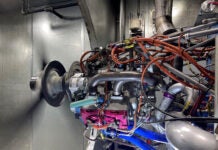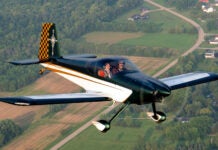
Kitplanes Contributor David Prizio, and Editor in Chief Paul Dye, were the first journalists to fly the new Diesel Sportsman from Glasair Aviation. The aircraft, a carbon version constructed specifically to test the new engine from Continental Motors – was flown at the Glasair factory in Arlington, Washington, and exhibited performance, fit, and finish far superior to what was expected from a prototype machine. The airframe and engine had about 42 hours on it when the Kitplanes pilots got their hands on it, and several more when they were finished – it was hard not to keep flying it. While absolute speed and climb performance is lower than with the IO-390, that is to be expected with an engine rated for considerably less power. There are advantages however – with the standard turbocharger, the climb power remained constant to approximately 8,000′. Cruise fuel consumption is on the order of 7 gallons per hour at economy, and less if the aircraft is slowed down. The test team at Glasair is expecting that they might be able to see ten hours of endurance with the power pulled back, and full tanks – and those tanks would be full of cheaper Jet A.

The aircraft and engine combination will be offered to customers when a few details have been worked out. For instance, Kitplanes flew it with an MT propeller but others are being considered, and performance might be improved. Indications are that early customers might be offered a considerable discount on the more expensive engine package – an incentive to get a few in the field and gain experience with the new 2.0 liter power plant, which TCM acquired from Germany and is fully supporting. The package features single-lever power control – the engine control units (dual) manage all engine parameters and propeller control to manage power, as demanded by the pilot, with a single beefy lever. No mixture or prop controls necessary. The installation was remarkably smooth, with prop speeds of 2300 RPM at an engine speed of about 3900.

The factory intends to have the demonstrator at Oshkosh for AirVenture next month, and expect it to draw a lot of attention as the first truly available, supported diesel engine installation for a kit plane. The demonstrator has a full interior with four seats, a multi-screen AFS EFIS, and diesel-specific controls and displays, making for a full (but easy to manage) panel.














